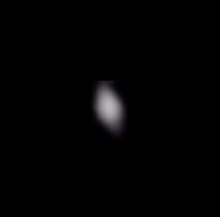Rosalind (moon)
Rosalind is an inner satellite of Uranus. It was discovered from the images taken by Voyager 2 on 13 January 1986, and was given the temporary designation S/1986 U 4.[8] It was named after the daughter of the banished Duke in William Shakespeare's play As You Like It. It is also designated Uranus XIII.[9]
- There is also an asteroid called 900 Rosalinde.
 The Hubble Space Telescope captured tiny Rosalind orbiting Uranus in 1997 | |
| Discovery | |
|---|---|
| Discovered by | Stephen P. Synnott / Voyager 2 |
| Discovery date | January 13, 1986 |
| Designations | |
Designation | Uranus XIII |
| Pronunciation | /ˈrɒzəlɪnd/[1] |
| Adjectives | Rosalindian /rɒzəˈlɪndiən/[2] |
| Orbital characteristics | |
Mean orbit radius | 69,926.795 ± 0.053 km[3] |
| Eccentricity | 0.00011 ± 0.000103[3] |
| 0.558459529 ± 0.000000019 d[3] | |
| Inclination | 0.27876 ± 0.045° (to Uranus' equator)[3] |
| Satellite of | Uranus |
| Group | ring shepherd |
| Physical characteristics | |
| Dimensions | 72 × 72 × 72 km[4] |
Mean radius | 36 ± 6 km[4][5][6] |
| ~16,000 km²[lower-alpha 1] | |
| Volume | ~200,000 km³[lower-alpha 1] |
| Mass | ~2.5×1017 kg[lower-alpha 1] |
Mean density | ~1.3 g/cm³ (assumed)[5] |
| ~0.012 m/s²[lower-alpha 1] | |
| ~0.031 km/s[lower-alpha 1] | |
| synchronous[4] | |
| zero[4] | |
| Albedo | 0.08 ± 0.01[7] |
| Temperature | ~64 K[lower-alpha 1] |
Rosalind belongs to Portia group of satellites, which also includes Bianca, Cressida, Desdemona, Portia, Juliet, Cupid, Belinda and Perdita.[7] These satellites have similar orbits and photometric properties.[7] Other than its orbit,[3] radius of 36 km[4] and geometric albedo of 0.08[7] virtually nothing is known about Rosalind.
In the Voyager 2 images Rosalind appears as an almost spherical object. The ratio of axes of Rosalind's prolate spheroid is 0.8-1.0.[4] Its surface is grey in color.[4]
Rosalind is very close to a 3:5 orbital resonance with Cordelia.[10]
See also
References
Explanatory notes
- Calculated on the basis of other parameters.
Citations
- Benjamin Smith (1903) The Century Dictionary and Cyclopedia
- Bertrand Evans (1966) Teaching Shakespeare in the high school, p. 213
- Jacobson, R. A. (1998). "The Orbits of the Inner Uranian Satellites From Hubble Space Telescope and Voyager 2 Observations". The Astronomical Journal. 115 (3): 1195–1199. Bibcode:1998AJ....115.1195J. doi:10.1086/300263.CS1 maint: ref=harv (link)
- Karkoschka, Erich (2001). "Voyager's Eleventh Discovery of a Satellite of Uranus and Photometry and the First Size Measurements of Nine Satellites". Icarus. 151 (1): 69–77. Bibcode:2001Icar..151...69K. doi:10.1006/icar.2001.6597.
- "Planetary Satellite Physical Parameters". JPL (Solar System Dynamics). 24 October 2008. Retrieved 12 December 2008.
- Williams, Dr. David R. (23 November 2007). "Uranian Satellite Fact Sheet". NASA (National Space Science Data Center). Retrieved 12 December 2008.
- Karkoschka, Erich (2001). "Comprehensive Photometry of the Rings and 16 Satellites of Uranus with the Hubble Space Telescope". Icarus. 151 (1): 51–68. Bibcode:2001Icar..151...51K. doi:10.1006/icar.2001.6596.
- Smith, B. A. (1986-01-16). "Satellites of Uranus". IAU Circular. 4164. Retrieved 2011-11-01.
- "Planet and Satellite Names and Discoverers". Gazetteer of Planetary Nomenclature. USGS Astrogeology. July 21, 2006. Retrieved 6 August 2006.
- Murray, Carl D.; Thompson, Robert P. (1990-12-06). "Orbits of shepherd satellites deduced from the structure of the rings of Uranus". Nature. 348 (6301): 499–502. Bibcode:1990Natur.348..499M. doi:10.1038/348499a0. ISSN 0028-0836.CS1 maint: ref=harv (link)

